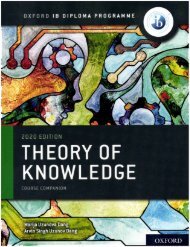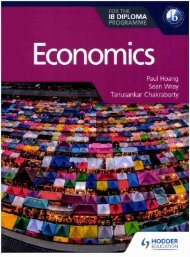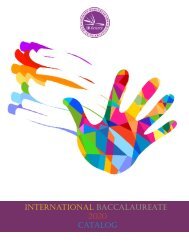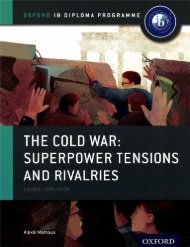SHELF 9780435183127 HISTORY PAPER 3 THE COLD WAR AND THE AMERICAS (1945-1981) STUDENT 60p
SHELF 9780435183127 HISTORY PAPER 3 THE COLD WAR AND THE AMERICAS (1945-1981) STUDENT 60p
SHELF 9780435183127 HISTORY PAPER 3 THE COLD WAR AND THE AMERICAS (1945-1981) STUDENT 60p
You also want an ePaper? Increase the reach of your titles
YUMPU automatically turns print PDFs into web optimized ePapers that Google loves.
Ceasefire negotiations began in Kaesong in )une 1951. This location within<br />
Communist-held territory proved problematic, with several serious incidents<br />
including armed Chinese'mistakenly'entering Kaesong in August; a Chinese platoon<br />
leader was shot and it was claimed that a UN plane had bombed the site (Chen). The<br />
talks were then called off, before resuming in Panmunjom on 25 October 1951 (Chen).<br />
China continued to insist on a seat in the United Nations and an end to US support for<br />
Taiwan. Other obstacles to peace also remained.<br />
. Both North Korea and China were prepared to drag out the war indefinitely to secure<br />
their demands, knowing public opinion in the US was already tiring of a long, drawnout<br />
war.<br />
. Syngman Rhee was still looking to reunify Korea under his leadership and did not<br />
want to support any peace deal that prevented this.<br />
. Prisoners ofwar (POWs) were held by both sides, but many of those held in the south<br />
did not want to retum home. Lowe states that the US was aware of this problem but<br />
even they greatly underestimated the numbers who did not want to leave South Korea,<br />
suggesting that only around 5,000 out of 21,000 Chinese; 54,000 out of 96,000 North<br />
Koreans; 4,000 out of 1 5,000 South Koreans andT ,500 out of 38,000 civilians wished to<br />
go back either to China or North Korea. The Chinese delegates vehemently denied this<br />
andblamed the US forhaving'indoannated'the POWs in their camps. Therewere also<br />
disputes over the number of POWs in custody. The US claimed that only 25 per cent of<br />
US MIAs (Missing in Action) were on the lists. North Korea and China also claimed that<br />
44,000 names on previous lists were nowmissing. In january 1952, the US proposed<br />
voluntary repatriation and those who did not want to return home would be released,<br />
on condition they did not bear arms again in the conflict (Chen).<br />
. On 28 April7952, one of the negotiators for China, Li Kenong, pointed out:<br />
TheTruman administration might notwant to end thewar at this momentfor two reasons: frst,<br />
in apresidential eleaionyearTrumaflwas concemed that a soft appearance might jeopardize the<br />
Democratic Par-Ly's electoral position; second, in order to inuease military expenditures in the<br />
19 53 budget, the KoreanW ar had to be continued.<br />
fian Chen (2001).Mao's Chiaa ondthe Cold W'ar. University of North Carolina Press, p. 109.<br />
The peace talks dragged on with no resolution, despite attempts by India to intervene as<br />
an 'honest broker' and to offer suggestions on how the POW impasse could be resolved.<br />
This photograph, taken in ,1956,<br />
shows ex-prisoners of war, who<br />
had been given asylum in lndia,<br />
choosing to re ocate to Brazil.<br />
'hey<br />
"'e<br />
berrg addressed here<br />
by the Brazilian Ambassador in<br />
Delhi.<br />
52















